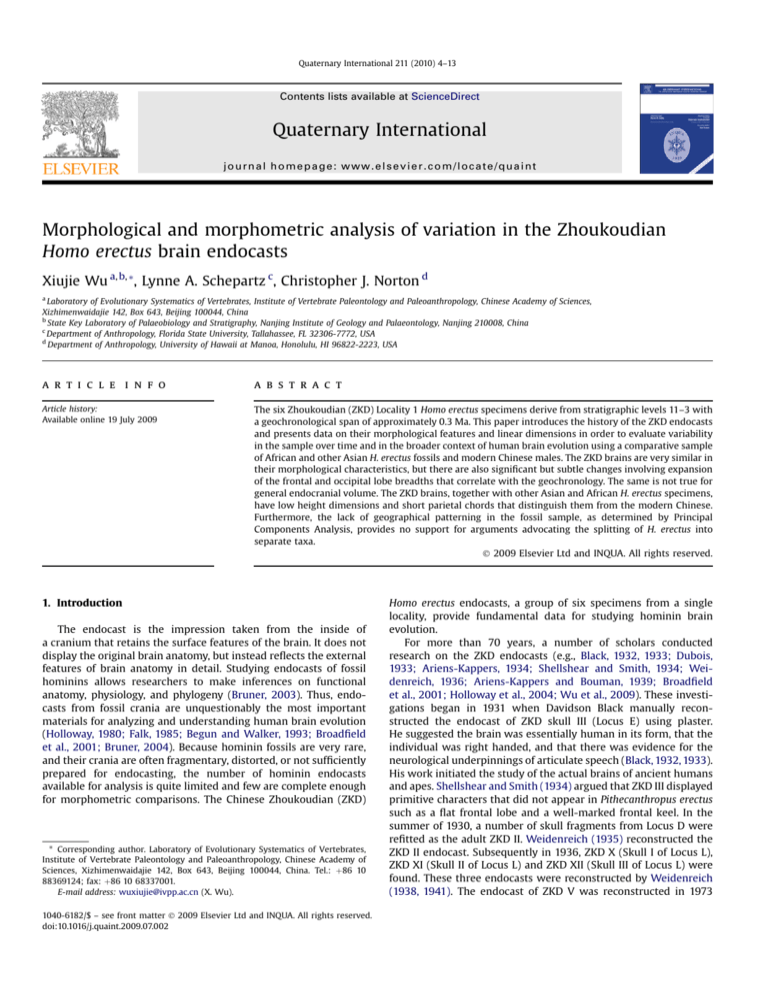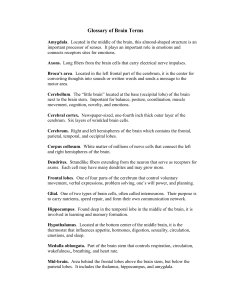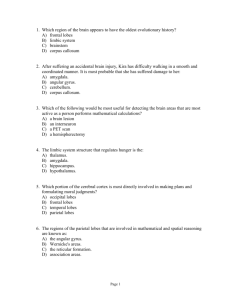
Quaternary International 211 (2010) 4–13
Contents lists available at ScienceDirect
Quaternary International
journal homepage: www.elsevier.com/locate/quaint
Morphological and morphometric analysis of variation in the Zhoukoudian
Homo erectus brain endocasts
Xiujie Wu a, b, *, Lynne A. Schepartz c, Christopher J. Norton d
a
Laboratory of Evolutionary Systematics of Vertebrates, Institute of Vertebrate Paleontology and Paleoanthropology, Chinese Academy of Sciences,
Xizhimenwaidajie 142, Box 643, Beijing 100044, China
b
State Key Laboratory of Palaeobiology and Stratigraphy, Nanjing Institute of Geology and Palaeontology, Nanjing 210008, China
c
Department of Anthropology, Florida State University, Tallahassee, FL 32306-7772, USA
d
Department of Anthropology, University of Hawaii at Manoa, Honolulu, HI 96822-2223, USA
a r t i c l e i n f o
a b s t r a c t
Article history:
Available online 19 July 2009
The six Zhoukoudian (ZKD) Locality 1 Homo erectus specimens derive from stratigraphic levels 11–3 with
a geochronological span of approximately 0.3 Ma. This paper introduces the history of the ZKD endocasts
and presents data on their morphological features and linear dimensions in order to evaluate variability
in the sample over time and in the broader context of human brain evolution using a comparative sample
of African and other Asian H. erectus fossils and modern Chinese males. The ZKD brains are very similar in
their morphological characteristics, but there are also significant but subtle changes involving expansion
of the frontal and occipital lobe breadths that correlate with the geochronology. The same is not true for
general endocranial volume. The ZKD brains, together with other Asian and African H. erectus specimens,
have low height dimensions and short parietal chords that distinguish them from the modern Chinese.
Furthermore, the lack of geographical patterning in the fossil sample, as determined by Principal
Components Analysis, provides no support for arguments advocating the splitting of H. erectus into
separate taxa.
Ó 2009 Elsevier Ltd and INQUA. All rights reserved.
1. Introduction
The endocast is the impression taken from the inside of
a cranium that retains the surface features of the brain. It does not
display the original brain anatomy, but instead reflects the external
features of brain anatomy in detail. Studying endocasts of fossil
hominins allows researchers to make inferences on functional
anatomy, physiology, and phylogeny (Bruner, 2003). Thus, endocasts from fossil crania are unquestionably the most important
materials for analyzing and understanding human brain evolution
(Holloway, 1980; Falk, 1985; Begun and Walker, 1993; Broadfield
et al., 2001; Bruner, 2004). Because hominin fossils are very rare,
and their crania are often fragmentary, distorted, or not sufficiently
prepared for endocasting, the number of hominin endocasts
available for analysis is quite limited and few are complete enough
for morphometric comparisons. The Chinese Zhoukoudian (ZKD)
* Corresponding author. Laboratory of Evolutionary Systematics of Vertebrates,
Institute of Vertebrate Paleontology and Paleoanthropology, Chinese Academy of
Sciences, Xizhimenwaidajie 142, Box 643, Beijing 100044, China. Tel.: þ86 10
88369124; fax: þ86 10 68337001.
E-mail address: wuxiujie@ivpp.ac.cn (X. Wu).
1040-6182/$ – see front matter Ó 2009 Elsevier Ltd and INQUA. All rights reserved.
doi:10.1016/j.quaint.2009.07.002
Homo erectus endocasts, a group of six specimens from a single
locality, provide fundamental data for studying hominin brain
evolution.
For more than 70 years, a number of scholars conducted
research on the ZKD endocasts (e.g., Black, 1932, 1933; Dubois,
1933; Ariens-Kappers, 1934; Shellshear and Smith, 1934; Weidenreich, 1936; Ariens-Kappers and Bouman, 1939; Broadfield
et al., 2001; Holloway et al., 2004; Wu et al., 2009). These investigations began in 1931 when Davidson Black manually reconstructed the endocast of ZKD skull III (Locus E) using plaster.
He suggested the brain was essentially human in its form, that the
individual was right handed, and that there was evidence for the
neurological underpinnings of articulate speech (Black, 1932, 1933).
His work initiated the study of the actual brains of ancient humans
and apes. Shellshear and Smith (1934) argued that ZKD III displayed
primitive characters that did not appear in Pithecanthropus erectus
such as a flat frontal lobe and a well-marked frontal keel. In the
summer of 1930, a number of skull fragments from Locus D were
refitted as the adult ZKD II. Weidenreich (1935) reconstructed the
ZKD II endocast. Subsequently in 1936, ZKD X (Skull I of Locus L),
ZKD XI (Skull II of Locus L) and ZKD XII (Skull III of Locus L) were
found. These three endocasts were reconstructed by Weidenreich
(1938, 1941). The endocast of ZKD V was reconstructed in 1973
X. Wu et al. / Quaternary International 211 (2010) 4–13
based on five fragments of cranium found in Locus H III. Two
fragments, consisting of the temporal and adjoining parietal and
occipital bones, were excavated in 1934 and described by Weidenreich (1935). More fragments of the cranium, including the
frontal, parietal, sphenoid and occipital bones, were found in 1966.
The endocranial volume was determined (Qiu et al., 1973), but no
detailed analysis of the endocast was undertaken until recently
(Wu et al., 2009).
In addition to the works on the ZKD endocasts mentioned above,
some broader comparative studies have included the ZKD specimens. For example, Begun and Walker (1993) compared the
endocast of KNM-WT 15000 with ZKD II, III, X and XII. They found
that the overall morphology of those specimens was quite similar
to KNM-WT 15000. However, they also found that the four ZKD
endocasts can be distinguished from KNM-WT 15000 by the
development of the superior sagittal sinus and the apparently welldeveloped connection between the sphenoparietal sinus and the
middle meningeal veins. Broadfield et al. (2001) found that the
endocast of Sambungmacan (Sm) 3 has a mosaic of features that are
shared with both other Indonesian H. erectus and ZKD III. Wu et al.
(2006) compared the endocast of Hexian with ZKD (II, III, X, XI and
XII), Sm 3 and KNM-WT 15000, and determined that Hexian is most
similar to the ZKD H. erectus specimens.
The ZKD hominins included in this study all derive from the
principal locality at Zhoukoudian designated Locality 1; a cave
complex located 50 km southwest of Beijing, China. The stratigraphic sequence was extensively studied and its designations
were revised by the different excavators, most notably Teilhard de
Chardin, Davidson Black and Jia Lanpo. ZKD III was found in Black’s
Layer 11 (Pei, 1929; Black et al., 1933; Lin, 2004) or Jia’s Layer 10 (Jia,
1959). ZKD X, XI and XII are from Layer 8/9 (Black et al., 1933; Jia,
1959). ZKD II is from Black’s Layer 8/9 or Jia’s Layer 10. ZKD V was
found in Layer 3 (Jia, 1959). Fig. 1 illustrates the approximate spatial
relationships of the six crania we used in this paper. ZKD V was
found in Layer 3; ZKD II, X, XI and XII are from Layer 8/9, and ZKD III
was found in Layer 11 (Lin, 2004).
A series of different dating studies have been conducted to
determine the absolute ages of the ZKD strata. Electron spin resonance (ESR) dating of mammal teeth collected from Layers 3, 4, 6–9,
11 and 12 suggests an age range of 0.28–0.58 Ma for the fossils
(Huang et al., 1993; Grün et al., 1997) with ZKD III at 0.58 Ma, ZKD II,
X, XI and XII all at approximately 0.42 Ma. The stratigraphically
highest specimen is ZKD V at 0.28 Ma. However, thermal ionization
mass spectrometric (TIMS) 230Th/234U dating on intercalated speleothem samples suggests that the age of the ZKD fossils is between
0.4 and 0.8 Ma (Shen et al., 2001). As a result, the age of ZKD V is
>0.4 Ma, possibly in the range of 0.4–0.5 Ma. The age of the hominin fossils from the lower strata is at least 0.6 Ma, and possibly
0.8 Ma or older (Shen et al., 2001). Shen et al.’s (2009) new dating
study, based upon cosmogenic 26Al/10Be burial dating on quartz
grains, suggests that the ages of Layers 7–10 of ZKD are between
0.68 and 0.78 Ma (Shen et al., 2009). The new age estimates imply
that the early ZKD specimens are probably contemporaneous with
Sangiran 17 that may date to 0.7 Ma (Swisher et al., 1994). While the
dating of the ZKD Locality I deposits is still debated, all of the results
document a considerable span of time (as much as 0.3–0.5 Ma)
between the oldest and youngest hominin fossils. An appreciation
of this temporal diversity is critical for any understanding of ZKD
hominin morphological variability.
This paper describes and interprets the morphology of the six
ZKD brain endocasts and compares them with endocasts from
China (Hexian, modern Chinese), Indonesia (Trinil II, Sangiran 2, 10,
12, 17, Sm 3) and Africa (KNM-ER 3733, 3883, KNM-WT 15000
and Salé) to develop a broader picture of variation at ZKD and in
H. erectus generally.
5
Fig. 1. Composite section of West Profile, ZKD Locality 1 showing the stratigraphic
positions of the cranial discoveries (Adapted from Jia, 1959).
2. Materials and methods
2.1. Endocasts
Table 1 is the catalogue of endocasts used in this study. The
specimens include representatives of Asian H. erectus (ZKD, Hexian,
Trinil II, Sangiran 2, 10, 12, 17, and Sm 3) and an outgroup of African
presapiens populations (KNM-ER 3733, 3883, KNM-WT 15000 and
Salé). Endocasts of ZKD III, ZKD II, ZKD X, ZKD XI, ZKD XII, ZKD V,
Hexian and Trinil II are from the collections of the Institute of
Vertebrate Paleontology and Paleoanthropology, Chinese Academy
of Sciences. The six ZKD endocasts are excellent first-generation
casts prepared from the original fossils. They therefore preserve
more detailed information than can be observed on the later
generation casts that are available to most researchers conducting
comparative endocast studies. Endocasts of 31 modern Chinese
males were made by the first author (Wu et al., 2006). They provide
a dataset representing general aspects of modern human brain
variation. Data for the endocasts of Sm 3, Sangiran 2, 10, 12, Sangiran 17, KNM-ER 3733, 3883, KNM-WT 15000 and Salé are from
published studies (see Table 1). The cranial capacities of all endocasts in the study are obtained by water displacement.
2.2. Methods
The research methodology employed here includes visual
inspection, descriptions of gross brain morphology, and then
quantification of size and shape differences.
Fig. 2 illustrates the principal regions of an endocast: the frontal
lobe, parietal lobes, temporal lobes, occipital lobe and the cerebellum. The specific features compared here are also indicated
6
X. Wu et al. / Quaternary International 211 (2010) 4–13
Table 1
Age (Ma) and cranial capacity (ml) for endocasts used in the study.
Endocast
Date (Ma)
Cranial capacity (ml)
Literature
ZKD III (Skull III, Locus E, Layer 11)
ZKD II (Skull II, Locus D I, Layers 8–9)
ZKD X (Skull X, Locus L I, Layers 8–9)
ZKD XI (Skull XI, Locus L II, Layers 8–9)
ZKD XII (Skull XII, Locus L III, Layers 8–9)
ZKD V (Skull V, Locus H III, Layer 3)
Hexian
Trinil II
Sm 3
Sangiran 2
Sangiran 10
Sangiran 12
Sangiran 17
KNM-ER 3733
KNM-ER 3883
KNM-WT 15000
Salé
Modern Chinese (n ¼ 31)
>0.80
0.68–0.78
0.68–0.78
0.68–0.78
0.68–0.78
>0.40
0.41
<1.0
0.9
0.98
1.2
0.9
0.7
1.75
1.57
1.51
0.40
Recent
915
1020
1225
1015
1030
1140
1025
940
917
813
855
1059
1004
848
804
880
880
1110–1600
Black et al., 1933; Weidenreich, 1943; Shen et al., 2001
Black et al., 1933; Weidenreich, 1943; Shen et al., 2009
Black et al., 1933; Weidenreich, 1943; Shen et al., 2009
Black et al., 1933; Weidenreich, 1943; Shen et al., 2009
Black et al., 1933; Weidenreich, 1943; Shen et al., 2009
Weidenreich, 1943; Qiu et al., 1973; Shen et al., 2001
Wu and Dong, 1982; Grün et al., 1998
Holloway, 1981; Swisher et al., 1994
Broadfield et al., 2001; Delson et al., 2001
Holloway, 1981; Swisher et al., 1994
Holloway, 1981; Swisher et al., 1994
Holloway, 1981; Swisher et al., 1994
Holloway, 1981; Swisher et al., 1994
Holloway, 1981; Brown et al., 1985
Holloway, 1981; Brown et al., 1985
Begun and Walker, 1993; Brown and McDougall, 1993
Holloway, 1981; Brown et al., 1985
This study
(Fig. 2A–D): the lateral Sylvian fissure area, middle meningeal
artery, sagittal keel (the prominence along the midline or sagittal
plane of the parietal or frontal lobes), venous sinuses, frontal pole,
occipital pole, Broca’s cap (the posterior surface of the third frontal
circumvolution) and frontal keel (a well-marked and prominent
orbital margin). The method for determining frontal and occipital
petalial patterns of asymmetry derives from LeMay et al. (1982),
who score which hemisphere protrudes further rostrally for the
frontal petalia and caudally for the occipital petalia, in addition to
which hemispheres are the broadest.
Following Begun and Walker (1993), nine linear measures were
taken to provide quantification of the overall shape of the endocasts (Table 2). The landmarks and standardized measurements are
described in detail by Wu et al. (2006). To take the measurements,
the endocast rests with the axis of the frontal and occipital poles
parallel to the table surface when viewed superiorly or laterally. The
length is measured from the anterior-most position of the frontal
lobe to the greatest posterior protrusion of the occipital lobe. The
breadth is the maximum width of the greatest lateral protrusion of
the endocast. The height is a projection from the highest point on
the parietal lobe to the most inferior point of the right cerebellar
hemisphere. Frontal breadth is the dimension between the greatest
lateral protrusions of the frontal lobe. Cerebral height is from the
highest point of the parietal lobe to the most inferior point of the
right temporal lobe. The frontal height is a projection from bregma
to the most ventral point of the right frontal lobe. The frontal chord
is bregma to the most anterior protuberance of the right frontal
lobe. The parietal chord is from bregma to lambda. The occipital
Fig. 2. Lateral view (A), posterior view (B), superior view (C) and anterior view (D) of an endocast, indicating anatomical landmarks. The lobes are delineated by dotted lines.
X. Wu et al. / Quaternary International 211 (2010) 4–13
7
Table 2
Endocast measurements (mm).
ZKD III
ZKD II
ZKD X
ZKD XI
ZKD XII
ZKD V
Hexian
Trinil II
Sm 3
Sangiran 2
Sangiran 10
Sangiran 12
Sangiran 17
KNM-ER 3733
KNM-ER 3883
KNM-WT 15000
Salé
Modern humans (n ¼ 31)
Length
Breadth
Height
Frontal breadth
Cerebral height
Frontal height
Frontal chord
Parietal chord
Occipital breadth
156.1
161.1
174.2
166.1
167.6
174.9
159.4
156.1
154.0
148.0
154.5
159.1
161.0
146.0
150.1
158.0
155.9
159.8–177.0
120.4
116.2
128.7
127.2
127.8
128.0
134.8
125.4
121.0
120.0
115.2
127.1
131.0
122.0
118.8
116.0
120.5
117.0–137.3
99.7
106.4
114.8
103.7
108.5
108.2
100.7
97.9
103.0
89.8
92.5
97.0
97.5
98.5
89.9
100.0
91.2
119.8–135.2
91.9
94.2
106.7
97.1
97.8
110.1
99.8
94.3
107.0
93.7
85.6
93.9
108.5
102.2
84.9
86.0
92.9
102.9–122.3
98.9
107.2
116.2
105.4
107.3
108.9
102.0
102.1
99.0
93.0
95.6
98.3
97.0
97.0
97.2
107.0
95.1
110.9–133.8
73.1
78.2
88.2
79.0
79.9
74.8
75.9
77.9
68.0
70.3
66.9
66.5
72.0
73.1
72.2
66.0
68.4
86.1–99.9
78.2
75.9
85.3
70.2
82.6
82.0
69.1
75.6
73.0
68.4
77.5
73.5
73.9
71.9
70.2
73.0
68.6
69.2–89.0
86.9
94.5
95.9
87.2
87.5
87.1
92.2
83.0
83.0
70.0
80.9
92.0
93.0
97.0
82.7
93.0
89.9
97.9–114.1
87.3
89.9
95.5
93.3
95.0
99.1
96.6
92.2
91.0
92.0
97.7
103.0
101.0
95.0
106.7
103.0
90.1
91.5–107.5
breadth is maximum width of the occipital lobe perpendicular to
the sagittal plane.
Statistical analyses were performed using SPSS 13.0. Bivariate
plots and a non-parametric statistic the Wilcoxon Signed Ranks test
were used to evaluate whether the dimensions of the ZKD specimens are significantly different. Tests of association (Spearman
rank-order correlations) between the measures of the ZKD specimens were performed to identify the bivariate dimensions with
significant correlations at the 0.01 level.
Principal component analyses (PCA) provide a perspective on
metric variation among the endocasts of ZKD and other specimens.
In order to run the PCA, the variables were scaled and the values
standardized. PCA included two components: 1) one with 48
specimens (17 fossils and 31 moderns) and nine log-transformed
measurements [log(length), log(breadth), log(height), log(frontal
breadth), log(cerebral height), log(frontal height), log(frontal
chord), log(parietal chord), and log(occipital breadth)]; 2) and
another with the same 48 specimens and 8 ratio measurements
(breadth/length, height/length, height/breadth, occipital breadth/
frontal breadth, frontal chord/parietal chord, frontal breadth/
breadth, occipital breadth/breadth and frontal height/cerebral
height).
3. Results
3.1. Gross morphology of the ZKD endocasts
Fig. 3 provides six views of the five ZKD endocasts arranged in
chronological order to facilitate comparisons. The inferior view
with the cranial base is not included as the majority of the basicranium is missing due to taphonomic, primarily postdepositional,
damage to all of the crania.
ZKD III (Locus E – 1932). The endocast is mostly complete except for
the base or foramen magnum area, the whole basi-occipital, and the
ethmoid region together with most of the sphenoid (Fig. 3, A1–A5).
It is widest at the level of the parietal eminences that are situated
one-third of the way from the occipital poles. Viewed superiorly
(Fig. 3, A1), the cast is long and narrow. From the parietal eminence
the brain surface slopes downward in all directions. Sagittal keeling
occurs along the central axis of the parietal lobe. Viewed anteriorly
(Fig. 3, A2), the frontal region of the endocast is flattened bilaterally
and bulges in the center of the frontal lobe. The frontal cap forms
a salient landmark in front of the most anterior point of the temporal
pole. In front of the frontal cap, the orbital margin is full and passes
forward to end in a well-marked and prominent frontal keel. The left
insular operculum of the frontal area is remarkably developed in size
and prominence relative to its counterpart on the right. Viewed
laterally (Fig. 3, A3–A4), the parietal region of this endocast is most
prominent and the frontal region is flattened. The lower border of the
frontal lobe and the upper border of the temporal pole are beveled.
The temporal region is narrow and the temporal pole is long and
slender. The middle meningeal vessels, visible in this view, are divided
into three branches on both the left and right. Upon entering the
middle cranial fossa, the middle meningeal vessels divide into
a short anterior branch that courses toward the temporal pole,
and a much longer posterior branch that caudally and becomes
elaborated in the region of the occipital parietal cortex. In posterior
view (Fig. 3, A5) the occipital forms a triangular elevation on the
posterior aspect of the cast. The occipital lobe is dorso-ventrally
flattened and has strong posterior projection, and the occipital poles
are especially prominent and rounded. The superior sagittal sinus is
divided into two branches and deviates to the right. ZKD III manifests
R-frontal and R-occipital petalial width patterns.
ZKD II (Locus D – 1935). The endocast of ZKD II consists of part of
the frontal lobe, the two parietal lobes, the greater part of the left
temporal lobe, and three small fragments of the occipital lobe
(Fig. 3, B1–B5). The widest point is situated at the lateral border of
the temporal lobes. Viewed superiorly (Fig. 3, B1), the cast is long
and very narrow. From the parietal eminence the brain slopes
downward in all directions. Sagittal keeling is also characteristic of
this specimen. Viewed anteriorly (Fig. 3, B2), the frontal region is
flattened. The orbital margin of the left frontal lobe is full. In lateral
view (Fig. 3, B3–B4), the left temporal region is narrow and the
temporal pole is long and slender. The middle meningeal vessels
are shown on the right side. They have a much longer posterior
branch that courses caudally and becomes elaborated in the region
of the occipital parietal cortex.
ZKD X (Locus L I – 1938). The endocast of ZKD X is almost
complete, and includes almost the entire frontal lobe except for the
lateral portion of the left side; the two parietal lobes, the entire
occipital lobe, nearly the entire right temporal lobe, and two small
fragments of the left temporal lobe (Fig. 3, C1–C5). The entire base
and the pterion region on both sides are missing. It is widest at
the level of the lateral border of the temporal lobes, approximately
one-third of the length from the occipital lobe. Viewed superiorly
(Fig. 3, C1), the endocast is long and narrow. From the prominent
vertex the brain slopes downward in all directions. Sagittal keeling
occurs along the central axis of the parietal lobes. Viewed anteriorly
8
X. Wu et al. / Quaternary International 211 (2010) 4–13
Fig. 3. From left to right: superior, frontal, right lateral, left lateral and posterior views of the six ZKD endocasts. They are in chronological order with the geologically youngest, ZKD
V, in the bottom row. A1–A5: ZKD III; B1–B5: ZKD II; C1–C5: ZKD X; D1–D5: ZKD XI; E1–E5: ZKD XII; F1–F5: ZKD V.
X. Wu et al. / Quaternary International 211 (2010) 4–13
(Fig. 3, C2), the frontal region bulges on both sides. As the pterion
region is missing, the form of the frontal cap and frontal keel cannot
be determined. As for the frontal, the temporal region is also
prominent and bulging. Meningeal vessels are visible on both
sides. On the right, the posterior ramus divides into two branches
(Fig. 3, C3). The anterior ramus is smaller than the posterior and has
a very small and short branch along the fissure of Sylvain area. On
the left side (Fig. 3, C4), the posterior ramus has more branches
than the anterior ramus. In posterior view (Fig. 3, C5) the occipital
has a semi-ovoid shape. There is asymmetry of the occipital poles,
with the left pole positioned more posteriorly than the right. The
superior and inferior polar eminences are asymmetrical bilaterally.
The position of the superior and inferior polar eminences on the
right are higher than on the left, but the superior and inferior polar
eminences on the left are posterior to those of the right side. The
groove for the superior sagittal sinus is visible from lambda.
The sagittal sinus runs downward along the groove and its course
deviates somewhat to the right. ZKD X shows L-frontal and
R-occipital petalial width patterns.
ZKD XI (Locus L II – 1938). The endocast of ZKD XI includes the
frontal lobes, the parietal lobes, the occipital lobe, and the temporal
lobes (Fig. 3, D1–D5). The basal portions anterior to the foramen
magnum are missing. The endocast is widest at the level of the
lateral border of the temporal lobes, at one-third of the length from
the occipital lobe. Viewed superiorly (Fig. 3, D1), the endocast is
long and narrow. From the highest point located centrally on the
parietal lobes, the brain slopes downward in all directions. There
are bilateral depressions of the parietal lobes. Sagittal keeling is
characteristic of this specimen. Viewed anteriorly (Fig. 3, D2), the
frontal region is flattened. The frontal cap forms a salient landmark
in front of the most anterior point of the temporal pole. Viewed
laterally (Fig. 3, D3–D4), the Sylvian area shows a distinct depression at the lower anterior region of the parietal lobe extending to
the upper region of the temporal lobe. The temporal region is
narrow and the temporal pole is long and slender. The meningeal
vessels are well preserved on both sides. The posterior rami are well
developed and have finer branches than the anterior rami. In
posterior view (Fig. 3, D5) the occipital forms a triangular elevation
on the posterior aspect of the cast. The positions of the superior and
inferior polar eminences on the right are higher and more posterior
than the left ones. The superior sagittal sinus is visible beginning as
a narrow ridge between the rostral cerebral poles, and becomes
marked at bregma. At the confluence, the superior sagittal sinus
becomes continuous with the right transverse sinus. ZKD XI shows
L-frontal and L-occipital petalial width patterns.
ZKD XII (Locus L III – 1938). The frontal lobe of the endocast of
ZKD XI is preserved almost completely, along with the left temporal
lobe, the entire occipital lobe including the posterior margin of the
occipital foramen, and nearly the entire right temporal lobe (Fig. 3,
E1–E5). ZKD XII is practically identical to ZKD XI, sharing all of the
features described above. ZKD XII shows L-frontal and L-occipital
petalial width patterns.
ZKD V (Locus H III – 1973; highest in the stratigraphic sequence).
The frontal and occipital lobes of ZKD V are almost complete, but
the base and part of the parietal lobes are missing (Fig. 3, F1–F5).
Viewed superiorly (Fig. 3, F1), the endocast is long and narrow.
Viewed anteriorly (Fig. 3, F2), the frontal region of the cast is flattened bilaterally and bulges in the center of the frontal lobe. The
frontal cap forms a salient landmark in front of the most anterior
point of the temporal pole. The orbital margin is full and ends in
a well defined and prominent frontal keel. Viewed laterally (Fig. 3,
F3–F4), the temporal lobes are narrow, and the Sylvian area
between the temporal and frontal lobes is a distinct depression. The
middle meningeal vessels are visible on the left side, and the
pattern is identical to that observed on ZKD XI and ZKD XII.
9
According to the preserved part on the left, the parietal lobes are
filled-out and bossed (Fig. 3, F4). The occipital lobe is dorsoventrally flattened with strong posterior projection, and the
occipital poles are especially prominent and rounded. The cerebellar lobes are anterior to the occipital lobe. Viewed posteriorly
(Fig. 3, F5), the superior longitudinal sinus groove becomes
continuous with the right sagittal sinus. ZKD V shows L-frontal and
R-occipital petalial width patterns.
As the above descriptions illustrate, the overall morphological
similarities among the ZKD endocasts are striking and notable. This
corresponds with the observations of Weidenreich (1943), who
emphasized the shared characteristics of the crania.
3.2. Comparison with other endocasts
The following observations are provided to highlight the
differences between the ZKD endocasts and the comparative
materials. In general, the widest point or greatest breadth of most
modern Chinese endocasts in this sample is situated at midway
along the length of the cast. In the ZKD endocasts and the other
H. erectus specimens, the widest point is usually located lower and
more posteriorly.
The surfaces of the frontal lobe of the H. erectus specimens (with
the exception of Sm 3) are flat, whereas the frontal lobes of the
modern Chinese are full and rounded. The frontal keel is prominent
on the ZKD specimens, Hexian, Trinil II, Sangiran 2, Sangiran 10,
Sangiran 12 and Sangiran 17, but is not present on Sm 3, KNM-ER
3733, KNM-ER 3883, Salé, KNM-WT 15000 and the modern Chinese
specimens. The area of the inferior frontal gyrus is slightly larger
and more prominent on the left side in all of the fossil endocasts
and the modern Chinese specimens compared here.
The ZKD III, II, X, XI, XII, and Hexian endocasts have sagittal keels
and depressed Sylvian areas (seen only on the left for Hexian and
ZKD V), in contrast to the flat, undepressed regions that characterize other H. erectus endocasts. Some of the modern Chinese in
our sample have a weak sagittal keel but they lack depressed Sylvian areas. Superiorly, the parietal lobes of the ZKD specimens and
Hexian are depressed, while other comparative endocasts have
round and full parietal lobes.
The temporal lobes of the ZKD endocasts are narrow and
slender. In contrast, Hexian, Sm 3, Trinil II, Sangiran 2, Sangiran 12,
Sangiran 17, KNM-ER 3733, KNM-ER 3883, KNM-WT 15000 and the
modern Chinese have fuller and broader temporal lobes.
The occipital lobes of the ZKD specimens, Hexian, Sangiran 2,
Sangiran 10, Sangiran 12, Sangiran 17 and Salé are dorso-ventrally
flattened and have strong posterior projections; the occipital lobes
of Sm 3, Trinil II, KNM-ER 3733, KNM-ER 3883, KNM-WT 15000 and
the modern Chinese are round and lack strong posterior projections. The cerebellar lobes are low and anterior to the occipital
lobes for the ZKD and other hominin endocasts in our sample. In
the modern Chinese sample, the cerebellar structures are more
globular, posteriorly positioned, and compact in their overall form.
The meningeal vessels of ZKD, Hexian, Sangiran 2, Sangiran 10,
Sangiran 12, Sangiran 17, Trinil II, and Sm 3 are similar as they all
have more branches overlying the middle to posterior regions (see
also Begun and Walker, 1993; Grimaud-Hervé, 1997; Holloway
et al., 2004). The anterior branch of the middle meningeal system
appears to be more developed on Salé, KNM-WT 15000, and the
modern Chinese in the sample. The venous sinus pattern varies
among the specimens, and there are no distinct patterns that
clearly distinguish the fossils from the modern comparative
materials. The petalia patterns of the ZKD endocasts are variable,
which is not the pattern characteristic of most modern humans
(cf. Holloway and De La Coste-Lareyondie, 1982).
10
X. Wu et al. / Quaternary International 211 (2010) 4–13
Table 3
Spearman rank-order correlations among the nine dimensions of the ZKD specimens.
Length
Breadth
Height
Frontal breadth
Cerebral height
Frontal height
Frontal chord
Parietal chord
Occipital breadth
Length
Breadth
Height
Frontal breadth
Cerebral height
Frontal height
Frontal chord
Parietal chord
Occipital breadth
1.000
.886*
1.000
.771
.771
1.000
1.000**
.886*
.771
1.000
.886*
.829*
.943**
.886*
1.000
.429
.543
.771
.429
.600
1.000
.600
.771
.829*
.600
.771
.486
1.000
.257
.257
.714
.257
.600
.829*
.371
1.000
1.000**
.886*
.771
1.000**
.886*
.429
.600
.257
1.000
**Significant at the 0.01 level (2-tailed). *Significant at the 0.05 level (2-tailed).
3.3. Metrical comparisons
3.3.1. Endocranial volume and metric data
Cranial capacities and geologic ages for the endocasts used in
the study are listed in Table 1. The cranial capacity of the oldest
ZKD H. erectus (ZKD III) is 915 ml; the average volume of ZKD II,
ZKD X, ZKD XI, and ZKD XII is 1072 ml; and the youngest ZKD
H. erectus (ZKD V) is 1140 ml. For the modern Chinese in our study,
the range is between 1110 ml and 1600 ml, with the average
volume 1382 ml. Both ZKD V and ZKD X fall within the modern
Chinese range. The average volume of the six ZKD endocasts
is 1058 ml, which places them in the middle of the range of
endocranial volumes obtained for a broad spectrum of H. erectus
crania ranging from 600 to 1251 ml (Rightmire, 2004). Specimens
that may not be H. erectus (the Ngandong crania as well as Dmanisi) are included in the calculation. Metric data for fossil endocasts and modern humans are listed in Table 2. All the fossil
endocasts are outside the range of the modern Chinese in terms of
height and parietal chord.
3.3.2. Non-parametric correlations
Table 3 shows the Spearman rank-order correlations among the
dimensions of the ZKD specimens. There are four pairs of correlations that are significant at the 0.01 level: length vs. frontal breadth,
Fig. 4. Bivariate plots of ZKD endocast measures: (A) length vs. frontal breadth, (B) length vs. occipital breadth, (C) height vs. cerebral height, (D) frontal breadth vs. occipital
breadth.
X. Wu et al. / Quaternary International 211 (2010) 4–13
Table 4
Principal Components Analysis of nine log measurements of ZKD, other Homo
erectus, and modern Chinese endocasts.
Variable
Log
Log
Log
Log
Log
Log
Log
Log
Log
length
breadth
height
frontal breadth
cerebral height
frontal height
frontal chord
parietal chord
occipital breadth
Component
1
2
.864
.604
.942
.875
.937
.918
.584
.888
.443
.136
.343
.230
.066
.176
.229
.242
.162
.742
length vs. occipital breadth, height vs. cerebral height, and frontal
breadth vs. occipital breadth.
3.3.3. Bivariate comparisons and non-parametric test
Bivariate plots of selected measures (Fig. 4) illustrate some interesting patterns. In the plots of length vs. frontal breadth (Fig. 4, A),
length vs. occipital breadth (Fig. 4, B), and frontal breadth vs. occipital
breadth (Fig. 4, D), there are significant relationships between the
two increasing measures. ZKD V is wider than the other ZKD specimens in frontal and occipital lobe, and longer than the others in
length. Wilcoxon Signed Ranks test shows that length and frontal
breadth, length and occipital breadth, and frontal breadth and
occipital breadth are significantly different at the 0.01 level
(p ¼ 0.028). Fig. 4(C) is a plot of height vs. cerebral height at ZKD. ZKD
X is higher than the other ZKD specimens. Wilcoxon Signed Ranks test
shows that there is no significant difference between height and
cerebral height (p ¼ 0.40).
3.3.4. Principal component analysis (PCA)
In the PCA of the nine log measures (Table 4 and Fig. 5, A), the
first two components account for 74.7% of the total variance. The
first component explains 64.6% of the total variation in the data
while the second PC explains 10.1%. The highest loadings for PC1
are for three variables that are measures of height: height, cerebral
height and frontal height. PC2 has the highest loading for occipital
breadth. Fig. 5(A) is a visual representation of the distribution for
the endocasts in the subspace of the first two PCs. The modern
Chinese cluster together and are principally removed from the
fossils (except ZKD X) on PC1. The ZKD specimens are close to
11
Hexian, Trinil II, Sm 3, Sangiran 17, KNM-ER 3733 and Salé on PC1.
ZKD II, ZKD III and ZKD XI are close to Trinil II, Sm 3, Sangiran 2,
KNM-ER 3733 and Salé on PC2. ZKD X, ZKD XII and ZKD V are close
to Hexian, Sangiran 17, Sangiran 12, Sangiran 10, KNM-ER 3883, and
KNM-WT 15000 on PC2.
In the PCA of the eight ratio measures (Table 5 and Fig. 5, B), the
first two components account for 71.8% of the total variance. The
first component explains 48.6% of the total variation in the data
while the second PC explains 23.2%. The highest loadings for PC1
are height/length, height/breadth and frontal breadth/breadth. PC2
has the highest loading for occipital breadth/breadth. In Fig. 5(B),
the modern Chinese cluster together and are principally removed
from the fossils. The ZKD specimens align closely with Hexian,
Trinil II, Sm 3, Sangiran 2, Sangiran 12, KNM-ER 3733, Sangiran 17,
and Salé. Sangiran 10, KNM-ER 3883 and KNM-WT 15000 are
distant from the ZKD specimens.
4. Discussion
The six ZKD H. erectus endocasts span over a 300,000 year
period, but they have marked morphological similarities. This
observation of a general bauplan, also emphasized by Weidenreich
(1943) for the cranial features, has long been viewed as the defining
characteristic of the ZKD sample. Weidenreich did, however,
recognize variation among the specimens that he did not attribute
to mere sexual dimorphism. Without the benefit of chronometric
dating, Weidenreich’s ability to appreciate the nature of temporal
change at ZKD was limited. He did estimate that ZKD V was possibly
the largest of the crania, although later recovery of more fragments
did not bear this out (ZKD X is larger). However, ZKD V does exhibit
the greatest development of the frontal and occipital breadth
expansion documented in this study. Qiu et al. (1973) noted that the
ZKD V specimen has more progressive features compared with the
other earlier ZKD specimens. Zhang (1991) suggested that there is
an evolutionary change in the direction of early Homo sapiens
morphology in the dental sample from Locality 1. Pei (1985)
considered Sinanthropus industry to exhibit certain evolutionary
developments, and he divided the Locality 1 industry into three
stages: early stage (the artifacts from Layer 11 to Layers 9–8),
middle stage (the artifacts from Layers 7 and 6), and late stage (the
artifacts from Layers 5–1). The present study supports the idea that
the ZKD V specimen is more progressive than the earlier ZKD
specimens.
Fig. 5. Principal Components Analysis of ZKD, other fossils and modern Chinese endocasts. (A) Nine variable PCA using log-transformed variables, (B) Eight variable PCA using ratios.
12
X. Wu et al. / Quaternary International 211 (2010) 4–13
Table 5
Principal Components Analysis of eight ratio measurements of ZKD, other Homo
erectus, and modern Chinese endocasts.
Variable
breadth/length
height/length
height/breadth
occipital breadth/frontal breadth
frontal chord/parietal chord
frontal breadth/breadth
occipital breadth/breadth
frontal height/cerebral height
Component
1
2
.372
.924
.914
.790
.646
.905
.161
.418
.729
.068
.341
.515
.029
.035
.902
.345
In light of the many new paleoanthropological discoveries over
the past 40 years, the taxonomic unity of H. erectus has been the
subject of much debate. Some researchers propose that the fossil
material subsumed under H. erectus should be split into African and
Asian species (Andrews, 1984; Stringer, 1984; Wood, 1984). Others
have argued that no distinct boundary exists between H. erectus
and H. sapiens in time or space, thus, H. erectus should be subsumed
within the evolutionary species H. sapiens (Wolpoff et al., 1994).
Some suggest that the ZKD crania possess unique morphological
and morphometric features that are not shared by the African and
other Asian samples (Kidder, 1998; Anton, 2002, 2003; Kidder and
Durband, 2004). Conversely, other researchers argue that cranial
features that were regarded as limited to Asian H. erectus are also
expressed in some African specimens (Braüer, 1994; Rightmire,
1998). Endocast data can be used to address some of these issues.
This study of H. erectus endocasts does not document any
geographical patterning that could be used to support a separation
of the African and Asian specimens. Interestingly, even the six ZKD
endocasts from a single locality do not form a discrete cluster with
clear separation from the other hominin fossils in our study.
Instead, the results document a significant trend for brain expansion over time within H. erectus, and basic similarities in the
underlying pattern of that expansion where brain enlargement is
a function of breadth. This differs from the pattern documented in
the modern H. sapiens, where height and parietal chord contribute
more substantially to changing brain size.
The marked changes in brain shape that occurred over time at
ZKD are not clearly evident from simple comparisons of total
endocranial volume or linear measurements. ZKD X is a case in
point in that it is the largest endocast and plots high above the
regression line in the bivariate plots of length vs. frontal breadth,
length vs. occipital breadth, and frontal breadth vs. occipital
breadth (Fig. 4). The nuances of the temporal changes at ZKD are
such that more sophisticated imaging analyses of the separate brain
regions’ shape and volumes are needed to further evaluate the
results of this study and their implications for hominin brain
evolution.
5. Conclusions
Documentation of the overwhelming morphological similarity
of the six ZKD endocasts, that are known to represent a 300,000
year time span, has significant relevance for our understanding of
H. erectus and hominin evolution and highlights the importance of
detailed site-specific analyses. The ZKD brain casts share several
features (low height and low position of the greatest breadth, flat
frontal and parietal lobes, depressed Sylvian areas, strong posterior
projection of the occipital lobes, anterior positioning of the cerebellar lobes relative to the occipital lobes, and relative simplicity of
the meningeal vessels) that distinguish them from the modern
Chinese. All of the fossils are outside the range of the modern
Chinese; they are characterized by much lower height measurements and have low height dimensions and shorter parietal chord.
It is this aspect, more than any other feature, which can be regarded
as the definitive characteristic of presapiens members of the genus
Homo.
Despite their general similarities, the ZKD endocasts also
provide evidence for significant changes in components of brain
breadth that are correlated with geologic time. The youngest fossil
in the sequence, ZKD V, has the greatest expansion of the frontal
and occipital lobes. In this capacity it exceeds ZKD X, the cranium
with the largest volume. For these reasons, it is important to factor
the temporal variation of the ZKD hominin fossils into considerations of H. erectus evolution.
Acknowledgments
We are grateful to Yinyun Zhang for his help in preparing the
endocast of ZKD V and his useful suggestions and encouragement.
This project is supported by the Knowledge Innovation Program of
the Chinese Academy of Sciences (Grant No: KZCX2-YW-106), the
International Cooperation Program of MST of China (Grant No:
2007DFB20330), the National Science Fund of China (Grant No:
40772018) and the State Key Laboratory of Palaeobiology and
Stratigraphy of Nanjing Institute of Geology and Palaeontology
(Grant No: 093109).
References
Andrews, P., 1984. An alternative interpretation of the characters used to define
Homo erectus. Courier Forshungsinstitut Senckenberg 69, 167–175.
Anton, S., 2002. Evolutionary significance of cranial variation in Asian Homo erectus.
American Journal of Physical Anthropology 118, 301–323.
Anton, S., 2003. Natural history of Homo erectus. Yearbook of Physical Anthropology
46, 126–170.
Ariens-Kappers, C.U., 1934. The fissuration on the frontal lobe of Sinanthropus
pekinensis Black, compared with the fissuration in Neanderthal men. Proceedings of the Koninklijke Nederlandse Akademie van Wetenschappen 36,
802–812.
Ariens-Kappers, C.U., Bouman, K.H., 1939. Comparison of the endocranial casts of
the Pithecanthropus erectus skull found by Dubois and von Koenigswald’s
Pithecanthropus skull. Proceedings of the Koninklijke Nederlandse Akademie
van Wetenschappen 42, 30–40.
Begun, D., Walker, A., 1993. The endocast. In: Walker, A., Leakey, R. (Eds.), The
Nariokotome Homo erectus Skeleton. Harvard University Press, Cambridge,
pp. 326–358.
Black, D., 1932. The brain cast of Sinanthropus, a review. Journal of Comparative
Neurology 56, 361–366.
Black, D., 1933. On the endocranial cast of the adolescent Sinanthropus skull.
Proceedings of the Royal Society B 112, 263–276.
Black, D., de Chardin, T., Young, C.C., Pei, W.C., 1933. Fossil man in China. The
Geological Survey of China and The Section of Geology of the National Academy
of Peiping. Peiping 11, 1–166.
Braüer, G., 1994. How different are Asian and African Homo erectus? Courier Forshungsinstitut Senckenberg 171, 301–318.
Broadfield, D.C., Holloway, R.L., Mowbray, K., Mowbray, K., Silvers, A., Yuan, M.S.,
Márquez, S., 2001. Endocast of Sambungmacan 3 (Sm 3): a new Homo erectus
from Indonesia. Anatomical Record 262, 369–379.
Brown, F.H., McDougall, I., 1993. Geologic setting and age. In: Walker, A., Leakey, R.
(Eds.), The Nariokotome Homo erectus Skeleton. Harvard University Press,
Cambridge, pp. 9–20.
Brown, F.H., Harris, J., Leakey, R., Walker, A., 1985. Early Homo erectus skeleton from
west Lake Turkana, Kenya. Nature 316, 788–792.
Bruner, E., 2003. Fossil traces of the human thought: paleoneurology and the
evolution of the genus Homo. Rivista di Antropologia 81, 29–56.
Bruner, E., 2004. Geometric morphometrics and paleoneurology: brain shape
evolution in the genus Homo. Journal of Human Evolution 47, 279–303.
Delson, E., Harvati, K., Reddy, D., Marcus, L.F., Mowbray, K., Sawyer, G.J., Jacob, T.,
Márquez, S., 2001. The Sambungmacan 3 Homo erectus calvaria: a comparative
morphometric and morphological analysis. Anatomical Record 262, 380–397.
Dubois, E., 1933. The shape and size of the brain in Sinanthropus and in Pithecanthropus. Proceedings Royal Academy of Amsterdam 36, 1–9.
Falk, D., 1985. Hadar AL162-28 endocast as evidence that brain enlargement
preceded cortical reorganization in hominid evolution. Nature 313, 45–47.
Grimaud-Hervé, D., 1997. L’évolution de l’enchéphale chez Homo erectus et Homo
sapiens. CNRS Editions, Paris, pp. 1–420.
X. Wu et al. / Quaternary International 211 (2010) 4–13
Grün, R., Huang, P.H., Wu, X.Z., Stringer, C.B., Thorne, A.G., McCulloch, M., 1997. ESR
analysis of teeth from the palaeoanthropological site of Zhoukoudian, China.
Journal of Human Evolution 32, 83–91.
Grün, R., Huang, P.H., Huang, W.P., McDermott, F., Thorne, A., Stringer, C.B., Yan, G.,
1998. ESR and U-series analyses of teeth from the palaeoanthropological
site of Hexian, Anhui Province, China. Journal of Human Evolution 34,
555–564.
Holloway, R.L., 1980. Indonesian ‘‘Solo’’ (Ngandong) endocranial reconstructions:
some preliminary observations with Neanderthal and Homo erectus groups.
American Journal of Physical Anthropology 53, 285–295.
Holloway, R.L., 1981. The Indonesian Homo erectus brain endocasts revisited.
American Journal of Physical Anthropology 55, 503–521.
Holloway, R.L., De La Coste-Lareyondie, M.C., 1982. Brain endocast asymmetry in
pongids and hominids: some preliminary findings on the paleontology of
cerebral dominance. American Journal of Physical Anthropology 58, 101–110.
Holloway, R.L., Broadfield, D.C., Yuan, M.S., 2004. The Human Fossil Record. In: Brain
Endocastsdthe Paleoneurological Evidence, vol. 3. Wiley-Liss, New York.
Huang, P.H., Jin, S.Z., Peng, Z.C., Liang, R.Y., Lu, Z.J., Wang, Z.R., Chen, J.B., Yuan, Z.X.,
1993. ESR dating of tooth enamel: comparison with U-Series, FT and TL dating
at the Peking Man Site. Applied Radiation and Isotopes 44, 239–242.
Jia, L.P., 1959. Report on the excavation of Sinanthropus site in 1958. Vertebrate
Palaeontology 1, 21–26.
Kidder, J.H., 1998. Morphometric variability in Homo erectus. American Journal of
Physical Anthropology 24 (Suppl.), 138.
Kidder, J.H., Durband, A.C., 2004. A re-evaluation of the metric diversity within
Homo erectus. Journal of Human Evolution 46, 297–313.
LeMay, M., Billing, M.S., Geschwind, N., 1982. Asymmetries of the brains and skulls.
In: Armstrong, E., Falk, D. (Eds.), Primate Brain Evolution. Plenum Press, New
York, pp. 263–277.
Lin, S.L., 2004. The first skull of Peking man was found in layer 11, not in layer 10.
Acta Anthropology Sinica 23, 173–186.
Pei, J.X., 1985. Thermoluminescence dating of the Peking Man site and another cave.
In: Wu, R.K., Ren, M.E., Zhu, X.M., Yang, Z.G., Hu, C.K., Kong, Z.C., Xie, Y.Y.,
Zhao, S.S. (Eds.), Multi-disciplinary Study of the Peking Man Site at Zhoukoudian. Science Press, Beijing, pp. 256–260 (in Chinese).
Pei, W.C., 1929. An account of the discovery of an adult Sinanthropus skull in the
Choukoutien deposit. Bulletin of the Geological Society of China 8, 203–250.
Qiu, Z.L., Gu, Y.M., Zhang, Y.Y., Zhang, S.S., 1973. Newly discovered Sinanthropus
remains and stone artifacts at Zhoukoudian. Vertebrata Palasiatica 11, 109–131.
Rightmire, G.P., 1998. Evidence from facial morphology for similarity of Asian and
African representatives of Homo erectus. American Journal of Physical Anthropology 106, 61–85.
13
Rightmire, G.P., 2004. Brain size and encephalization in early to mid-Pleistocene
Homo. American Journal of Physical Anthropology 124, 109–123.
Shellshear, J.L., Smith, G.E., 1934. A comparative study of the endocranial cast of
Sinanthropus. Philosophical Transactions of the Royal Society of London Series B
223, 469–487.
Shen, G., Ku, T., Cheng, H., Edwards, R., Yuan, Z., Wang, Q., 2001. High-precision Useries dating of Locality 1 at Zhoukoudian, China. Journal of Human Evolution
41, 679–688.
Shen, G., Gao, X., Gao, B., Granger, D., 2009. Age of Zhoukoudian Homo erectus
determined with 26Al/10Be burial dating. Nature 458, 198–200.
Stringer, C., 1984. The definition of Homo erectus and the existence of the species in
Africa and Europe. Courier Forshungsinstitut Senckenberg 69, 131–143.
Swisher III, C.C., Curtis, G.H., Jacob, J., Getty, A.G., Suprijo, A., Widiasmoro, 1994. Age
of the earliest known hominids in Java, Indonesia. Science 263, 1118–1121.
Weidenreich, F., 1935. The Sinanthropus population of Choukoutien (Locality 1) with
a preliminary report on new discoveries. Bulletin of the Geological Society of
China 14, 427–461.
Weidenreich, F., 1936. Observations on the form and proportions of the endocranial
casts of Sinanthropus pekinensis, other hominids and the great apes: a comparative study of brain size. Paleontologica Sinica NSD 7, 1–50.
Weidenreich, F., 1938. The ramification of the middle meningeal artery in fossil
hominids and its bearing upon phylogenetic problems. Paleontologica Sinica,
New Series D 3, 1–16.
Weidenreich, F., 1941. The brain and its role in the phylogenetic transformation of
the human skull. Transactions of the American Philosophical Society, New
Series 31, 321–442.
Weidenreich, F., 1943. The skull of Sinanthropus pekinensis: a comparative study on
a primitive hominid skull. Paleontologica Sinica, New Series 10, 108–113.
Wood, B.A., 1984. The origin of Homo erectus. Courier Forshungsinstitut Senckenberg 69, 99–111.
Wolpoff, M.H., Thorne, A.G., Jelı́nek, J., Zhang, Y.Y., 1994. The case for Sinking Homo
erectus. 100 Years of Pithecanthropus is Enough!. Courier Forschungsinstitut
Senckenberg 171, 341–361.
Wu, R.K., Dong, X.R., 1982. Preliminary study of Homo erectus remains from Hexian,
Anhui. Acta Anthropologica Sinica 1, 2–13.
Wu, X.J., Schepartz, L., Falk, D., Liu, W., 2006. Endocast of Hexian Homo erectus from
south China. American Journal of Physical Anthropology 130, 445–454.
Wu, X.J., Schepartz, L., Liu, W., 2009. Endocranial cast of Zhoukoudian skull V: a new
Homo erectus brain endocast from China. Proceedings of the Royal Society B.
doi:10.1098/rspb.2009.0149 Published online before print April 29, 2009.
Zhang, Y.Y., 1991. An examination of temporal variation in the hominid dental
sample from Zhoukoudian Locality 1. Acta Anthropologica Sinica 10, 85–95.








